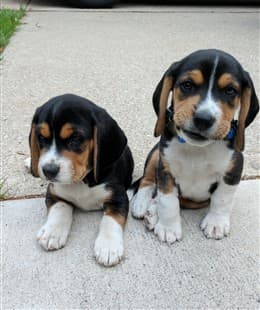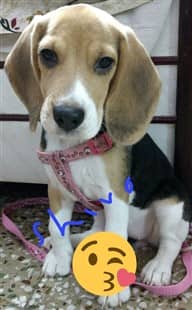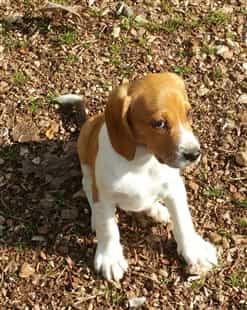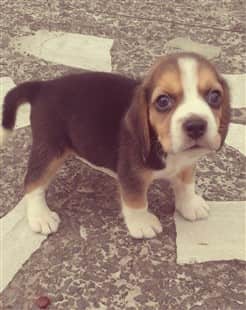House Training a Beagle
Overview
Housebreaking your Beagle will be one of the most challenging, yet rewarding, types of training that you and your Beagle will work on together.
Beagles are a breed that love to please their owners, so this trait only serves to make things easier. However, for the fastest route to success, it is important to follow certain guidelines.
The fundamentals of house training a Beagle are not overly complicated; however, the details are vital including proper prepping, rules, and reward.
Please note:
BeaglePro is reader-supported, and some of the product suggestions on this page are affiliate links. As an Amazon Associate we earn from qualifying purchases. This is at no extra cost to you and helps us keep this site running.
Age Elements
Pups younger than 8 weeks old
may be advertised as 'paper trained' by breeders; however, this is more coincidence than it is actual training. When you bring your new Beagle puppy home, you will want to start housebreaking with your own rules.
Beagles as young as 8 weeks old
can start being housebroken. Note that a puppy should not be brought to any outside area in which there is a chance that other dogs have been there (other than your own, if you know that they are up-to-date on vaccinations), or wildlife has been there, until all puppy shots are complete.
While you will need to check with your veterinarian as to when this will be, it is most often by the 12 to 14 week mark.
Adult Beagles of any age can learn to be house trained; this is very common with rescued Beagles that either need to start from scratch or require acclimation to your household's rules.
5 Things to Have in Place Before You Start House Training Your Beagle
There are certain things that need to be planned and prepped for, in order to be able to housebreak your Beagle in a clear, consistent, and effective manner.
The following 5 tips will allow this process to run smoothly, with as few hiccups as possible.
1. A Designated Area
A huge mistake that owners make is just opening the back door and allowing their Beagle to go 'anywhere' as long as it is outside. However, having a Beagle urinate or defecate in the area that he happens to be does not quality as true training.
For success, you will want to carefully choose a designated bathroom area. This should be a location that is easily accessible no matter the weather, and not overly close to any spots that are used by the family such as a child's swing-set or the barbecue.
2. A Method of Containment
A Beagle puppy on the loose inside the house will pee and poo in every corner of that house and most likely on the carpet, on your shoes, behind the sofa, under the kitchen table, well, you get the picture.
So, until your Beagle is 100% fully trained, you will want to contain the messes during all times
that you cannot keep a very close eye on your pup. The method that you use will depend on your Beagle's age and the layout of the home.

Since a pen is a contained, structured area, and the bed, toys, water bowl, and food (either in a treat release toy or a bowl) will be taking up space, any remaining space should be covered with pads.
Dogs rarely soil their own belongings, so chances are high that urine and stools will be deposited on the pads.
Note that there are two main types of indoor pens, those with doors and those without. We recommend the type with doors. Typically, a Beagle will learn to love his 'den', and will want to be able to exit and enter as desired (when you are there to supervise).
If you wish to obtain a pen,
the IRIS Pet Pen
 comes in various sizes, with add-ons, or you may want to start off with a larger one in anticipation of how much your Beagle will be growing.
comes in various sizes, with add-ons, or you may want to start off with a larger one in anticipation of how much your Beagle will be growing.
3. A Supervision Method

Shiro, at 4 months old,
photo courtesy of Aswathi Menon
Each and every time that a puppy urinates or eliminates indoors, is a step in the wrong direction. So, you will want to have a method of ensuring that when your Beagle is with you inside the house, this is a very closely monitored supervision.
One of the easiest methods to do this, is to tether your pup or dog to you with a 6-foot leash. This way, your Beagle will never be more than a few steps away, and you'll always be able to catch your pup at the instant there's a motion to pee or poo (exact directions as to how to react are coming up).
To tether your Beagle to you, there are 2 things that you will need:
1. A harness.
It is recommended to have your Beagle on a harness, and not a collar. This will help prevent neck injury as you both move around. One harness that we recommend is the Puppia Soft Dog Harness , which is super comfortable, easy to get on and off, is adjustable, and comes in 12 different colors.
, which is super comfortable, easy to get on and off, is adjustable, and comes in 12 different colors.
2. A 6-foot soft-handled leash.
Since you'll be connecting one end of the leash to your pup's harness, and the other to you, it's easiest to do this if the leash has a soft handle.
With one like Downtown Pet's Durable Soft Dog Leash , you can slip the handle over your wrist or you can slip it through your belt loop.
, you can slip the handle over your wrist or you can slip it through your belt loop.
4. Chosen Cue Words
You may not have given much thought to what you're going to say when you housebreak your Beagle, or maybe you've already started and just say whatever comes to mind at the moment. However, the words that you use will have a big impact on how quickly your Beagle learns.
Dogs are pretty smart, and do best when they can connect words or phrases to actions. Therefore, if you say different things each time, or if other family members that bring your Beagle out use their own terminology, this can impede house training.

Beauregard, at 2 and 1/2 months old,
photo courtesy of Amy
5. Training Treat Rewards
While your praise does play a role in house training, dogs learn much faster when they have maximum motivation to perform certain actions. And the fastest, most effective method of making it exceedingly clear that an action is a desired action is to reward it with a treat within 3 to 5 seconds.
Here are some tips to keep in mind:
- The treat should not be one that will be given out at any rate later in the day. One particular treat should be reserved just to reward housebreaking. If you've already found a super-healthy treat that your Beagle loves, look for the same one but in a different flavor; i.e. salmon instead of lamb.
- The treat should be small. Reward should deliver a pleasing taste immediately; this is not something that a Beagle should have to sit down to chew on.
- It should be moist. Most Beagles have a pretty hardy appetite and are not that choosy when being given food; however, in regard to training and sending clear messages, moist treats work better than dry ones.
- The training treats should be held to the same high standards of main meals. This means no chemical preservatives, artificial flavoring, corn, soy, wheat, or by-products. In addition, you may wish to go with grain-free.
- Since reward must be immediate, you'll want to keep a few treats in a zipped plastic bag, and placed right by the exit door. You'll want to be able to quickly grab it and slip it into your pocket each time you bring your Beagle out.
Some of our top recommended treats to help housebreak a Beagle are all grain-free, and are top-quality choices. There is Zuke's Mini Naturals Dog Treats , which can be found in wholesome peanut butter, salmon, duck, pork, and rabbit.
, which can be found in wholesome peanut butter, salmon, duck, pork, and rabbit.
There is also Wellness Puppy Bites Natural Puppy Training Treats , which offers two great combinations of lamb & salmon or chicken & carrots.
, which offers two great combinations of lamb & salmon or chicken & carrots.
And last but not least, is the top quality Merrick Power Bites Dog Treats , which offers great wholesome flavors of chicken, Texas beef, salmon, and turkey & duck.
, which offers great wholesome flavors of chicken, Texas beef, salmon, and turkey & duck.
How to House Train a Beagle
Now that you are fully prepped, with a designated area chosen, a method of keeping your Beagle in one spot when you are not right there, a way to very closely supervise your pup when you are there, you have the cue words chosen, and training treats are waiting by the door, you'll be ready to start training your Beagle.

Here's what to do:
1. Take your Beagle outside at all of the following times:
- As soon as your pup wakes up, both in the morning and after any naps
- 20 minutes after a meal
- As soon as you get home, if you were away
- Right before bedtime
- Any time that you are supervising your pup and there's a motion to pee or poo (lifting a leg or squatting)
- Every certain number of hours, depending on age. This is 2 hours for a 2-month old, every 3 hours for a 3-month old, etc.
- Both before and after a walk. Do not make the mistake of allowing your Beagle to just pee and poo along a walking route. This is a huge missed opportunity to teach housebreaking rules. Always visit the designated area first. If your Beagle pees or poos afterward while out and about, that is okay.
2. If you catch your Beagle making a motion to go to the bathroom inside the house, act quickly.
You'll want to interrupt the action by loudly clapping your hands and/or letting out a firm 'No' and then either very quickly leading your pup outside, or carrying him to the outside area.
3. Each time that you bring your Beagle out, say the chosen cue words.
Say this in a happy tone, even if you're frustrated because your pup almost peed all over your carpet.
4. Bring your Beagle to the area, and stand in the middle of it. Allow your pup to sniff around and choose the 'perfect' spot. When a dog has a choice in the matter, he does much better.
5. Be patient and prepared to wait.
It can take up to 15 minutes for bladder and/or bowel muscles to relax enough. If you are not dressed right for the weather or if you forgot your phone inside, you may lose your patience and come in before your Beagle has had a chance to go.
6. Give praise and reward.
As soon as your Beagle is done peeing or poo'ing, give great praise using the cue words; for example, 'Good potty, Good dog!' as you are offering the training treat.

7. If your Beagle has urinated, but you believe that your pup may need to have a bowel movement, remain in the area for an additional 10 minutes.
8. If your Beagle has an accident
- Note that if your Beagle is always in his pen when you are not home, and is always tethered to you when you are home, chances of accidents are extremely low.
However, if an accident occurs, it's vital to clean this in the right way.
Urine and stools contain certain enzymes. Soap and water do not remove these. After cleaning the spot, while you will probably not smell a thing, if enzymes remain, these will be a kin to a huge sign flashing a loud announcement that that spot is a bathroom area. And your Beagle will be much more prone to pee or poo there again.
To avoid this problem, you'll want to clean up the stools or urine, and then scrub the area while using a quality enzyme cleaner. And this goes for any
type of flooring, not just carpeting. You'll want to use a this sort of cleaner on wood, laminate, tile, carpeting, and any other material, including furniture if any urine splashed up.
One of our recommended cleansers for bathroom accidents is Sunny and Honey's Pet Stain & Odor Miracle Enzyme Cleaner ; this works on any sort of surface or upholstery, is safe to use around pets, and is safe to use in household with children.
; this works on any sort of surface or upholstery, is safe to use around pets, and is safe to use in household with children.
Helpful Hints
1)
If your puppy seems to always pee right after you get back into the house, this can easily be fixed. Wait the 15 minutes or so at the designated area, and if nothing happens outside, bring him back inside, but hold him on your lap. He will be hesitant to have an 'accident' on you. Then, in 5-10 minutes, go back outside again.
2)
Don't grow tired of offering praise, and don't fully phase out rewards. Some owners show tons of excitement during the first week or so of house training, but that seems to get less and less as the days and weeks go by.
Puppies need consistent motivation to be fully housebroken. And it is best to remind adult dogs that they are doing well.
3)
If you just brought home an older Beagle, do not rely on any previous house training. You may not know the dog's signals for having to go outside. Some Beagles let out a whine or a bark, some sniff near the door, others will paw at you.
In addition, your new dog will not know the exact area that you've chosen to serve as the bathroom area, and as we mentioned earlier, just having your Beagle go 'anywhere' outside is not the most effective method.
Related:
Beagle Frequent Urination: What may cause a Beagle to suddenly pee more often and exactly what to do.
How to Stop a Beagle from Marking: Though related, territorial marking is a behavioral issue, not a housebreaking matter. Read what causes a dog to mark and exact steps to stop this.
You May Also Like:
Beagle Care Tips: The 7 most important tips to follow for optimal health, happiness, comfort, and safety.
Beagle Flea, Tick, and Worm Prevention: Confused about what is needed, and which products are best? A great guide to follow for both puppies and adults.
Best Toys for a Beagle: If your Beagle is ignoring his toys, or if chewing urges are not being satisfied, see which toys work best for both Beagle pups and adults.



